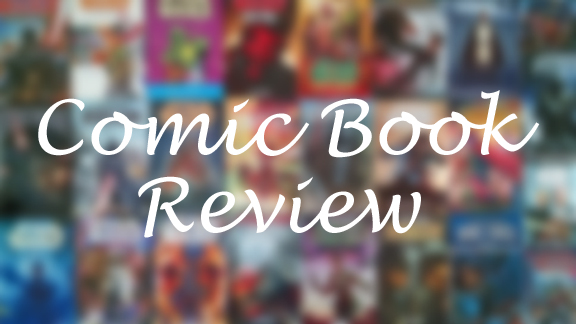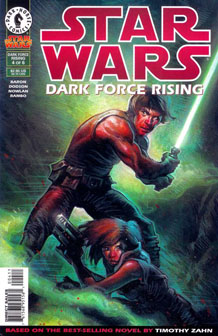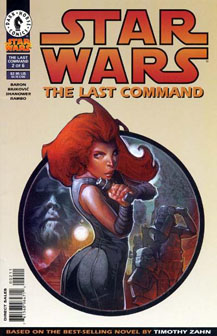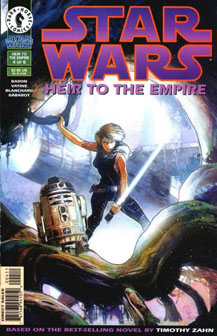Somewhat surprisingly, only five “Star Wars” books have been adapted into comics: “Han Solo at Stars’ End” (adapted as a comic strip and later reorganized into comic-book form by Dark Horse) and “Splinter of the Mind’s Eye” are two of them, and Timothy Zahn’s 1991-93 Thrawn Trilogy – “Heir to the Empire” (1995-96), “Dark Force Rising” (1997) and “The Last Command” (1997-98) – accounts for the other three.
(I’m not counting the book/comic multimedia projects – “Shadows of the Empire” and the “Force Unleashed” duology – as adaptations.)
Mike Baron adapts all three books as six-issue series, and does his best work on “The Last Command” because it’s the most cinematic and because he improved as he went along – “Last Command” crams in more panels and words, but also has more splash panels for establishing shots and emphasis (like when C’baoth explodes into a beam of light after Mara stabs him).

‘Star Wars’ Thrawn Trilogy comic adaptations
Dark Horse Comics, 6 issues each
Titles: “Heir to the Empire” (1995-96), “Dark Force Rising” (1997) and “The Last Command” (1997-98)
Writer: Mike Baron
Pencils: Olivier Vatine, Fred Blanchard (“Heir”); Terry Dodson (“DFR”); Edvin Biukovic (“TLC”)
Inks: Olivier Vatine, Fred Blanchard (“Heir”); Kevin Nowlan (“DFR”); Eric Shanower (“TLC”)
Colors: Isabelle Rabarot (“Heir”); Pamela Rambo (“DFR” and “TLC”)
The first two books suffer from chunks of story that don’t make sense because Baron includes only dialogue that conveys plot information at the expense of natural conversational flow. “Dark Force Rising” is particularly plot-heavy, which makes for a great novel but a clunky comic. Unavoidably, all three adaptations feel like books turned into comics, with tons of dialogue bubbles.
Biukovic combines beauty and flow
There’s only one significant liberty taken with the narrative. Artist Edvin Biukovic (who gained quite a fan base with “X-Wing Rogue Squadron: The Phantom Affair”) concludes the first issue of “Last Command” with the ghosts of Obi-Wan, Yoda and Anakin overlooking the newborn Jacen and Jaina. It seems to contradict the “Heir” novel, when Obi-Wan tells Luke he’ll no longer appear to him.
Beyond that, the adaptation is faithful, unfortunately including the major plot hole at the end of “Command” when Karrde’s smuggler group goes after a crystal gravfield trap (CGT) even though the Republic no longer needs it, as Karrde knew at that point that all of the cloaked asteroids surrounding Coruscant had already been destroyed.

So mostly we picked up the Thrawn Trilogy comics for the art. Biukovic’s pencils and inks on “The Last Command” are the best, because he combines strong likenesses, beautiful individual panels and a kinetic flow. Olivier Vatine (pencils) and Fred Blanchard (inks) take a stylized approach to likenesses on “Heir,” but their action flows nicely. However, I don’t like “Heir’s” watercolor-esque coloring (reminiscent of “Dark Empire”) as much as the sharper, livelier colors on “Last Command.”

While the individual panels by Terry Dodson (pencils) and Kevin Nowlan (inks) on “Dark Force Rising” aren’t bad, the women look like standard manikin-esque comic-book women and there’s no kinetic energy from page to page, so despite it being my favorite Zahn book, it’s the weakest comic adaptation.
Mara gets her iconic look
This series’ most valuable contribution to the lore is character design. While we may have had images in our heads of what Mara, Thrawn and Karrde looked like – and perhaps we were influenced by character guides, roleplaying game books and the novels’ cover art – these comics solidified the visual portrayals of Zahn’s characters, many of whom would become mainstays in the Expanded Universe.
Most notable is Mara Jade, with her red locks; sleek, sleeveless jumpsuit; hood/scarf and pilot’s goggles. Even more so than in the books alone, Mara is the breakout star of the Thrawn Trilogy here because she has such an iconic look that lends itself to comic storytelling. (I’m referring to the fashion choice as demonstrated by Mara model Shannon McRandle.) Indeed, “Mara Jade: By the Emperor’s Hand” wouldn’t have existed without the overwhelmingly positive reception to Mara in this series.

Thrawn – with blue skin, red eyes and a white Grand Admiral’s uniform, was perhaps easiest to portray. And Karrde looks like a smuggler should look – goatee, long hair, sleeveless vest. C’baoth also looks exactly how I expected: A crazy-eyed old man with a long white beard and mane. Same with Garm Bel Iblis: Kind of a cleaner-dressed answer to Karrde. The comics’ portrayal of Fey’lya and Bothans in general is perfect, and much better than what I saw in my mind’s eye – taller versions of Kubaz.
Some surprising designs
Because Zahn didn’t provide detailed descriptions of everyone, there are some surprises: For example, Mazzic, a member of Thrawn’s smuggler coalition in “The Last Command,” is not a human but rather a member of the Myke species, who look like Nightcrawler from “X-Men.”
Most controversial, to judge by the letter columns, are the varying portrayals of the Noghri. When I first read the books, I pictured them as being about the size of Jawas, with their lethality coming from their quiet assassin skills – a classic case of “size matters not.”
“Heir to the Empire” artists Vatine and Blanchard thought bulkiness would convey their dangerous nature better, but in “Last Command,” Biukovic gets them right, scaling them back down to Jawa size (indeed, they disguise themselves as Jawas in the third book) but still giving them creepy faces with prominent nostrils. (“Dark Force Rising” has the Noghri’s size right, but makes them look tame.)
To me, the portrayal of Pellaeon went in the opposite direction from the Noghri — from pretty close to dead wrong. In “Heir,” Thrawn’s second-in-command is a stern-looking man just beyond middle age. That seems about right, although I picture him having a mustache. For no good reason, Pellaeon gets ‘roided up and younger in “Dark Force Rising,” and is only slightly better in “Last Command.”
Visualizing Zahn’s tech
We also get definitive looks at Zahn’s tech creations. I remember that the Imperial Interdictor Cruiser initially surprised me. I didn’t realize it looked exactly like a Star Destroyer, only with four bubbles that project gravity wells. The sheer immensity of the sunlight-blocking shieldship that escorts the Falcon and Luke’s X-wing to Lando’s Nkllon mining facility is something the comic captures better than prose.
My favorite environmental portrayal is Wayland in “Last Command,” as Biukovic gives us time to soak up the forest and the interior of the Mount Tantiss warehouse, which includes a Death Star-style bottomless pit as the structure’s central column, plus C’baoth’s throne room, which is patterned precisely after “Return of the Jedi.”
On an obscure note, the Thrawn Trilogy comics contradict George Lucas’ argument that there’s no underwear in space (he famously had Carrie Fisher’s breasts taped together with gaffer tape on “A New Hope”). Leia runs around in her underwear throughout the Kashyyyk scenes in “Heir.” That, along with Mara’s somewhat unnecessary nude scene in the first issue of “Last Command,” caused quite a stir in the letters pages. No complaints here, though.
On one level, I wish there were more “Star Wars” book-to-comic adaptations, but all told, I’m glad Dark Horse generally used its time and talent pool to tell original stories. Even with the Thrawn Trilogy – which tops the list of most essential EU books – the comics are merely a nice supplement rather than a replacement of equal value.

